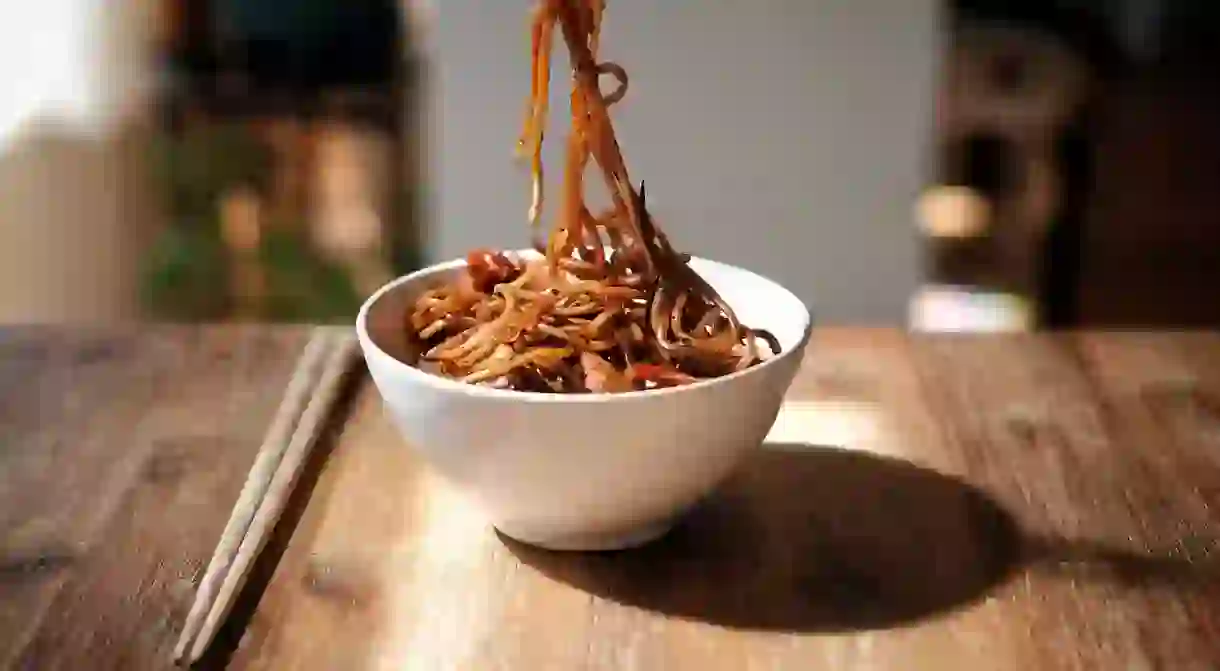10 Authentic Alternatives to Western-Chinese Foods

Western-Chinese food might be delicious, but it is rarely authentic. In fact, many of the dishes found in take-out restaurants across the U.S. and Europe were invented in New York or California, not in China. So, if you love the cuisine but want to branch out into more authentically Chinese territory, here are some must-try dishes.
Lazi Ji – Alternative to General Tso’s Chicken
Practically synonymous with westernized Chinese food, General Tso’s Chicken is made with deep-fried chicken chunks seasoned with hot chili peppers, scallions, ginger, garlic, and sesame oil. Lazi ji translates roughly to “chillies and chicken” and will please General Tso’s fans with its hearty spiciness. Similar to the Western classic, lazi ji is made with deep-fried chicken chunks, but it is typically flavored with Sichuan peppers, bean paste, garlic, and ginger.

Dingding Chaomian – Alternative to Chow Mein
Chow mein actually isn’t far off from real Chinese food. In fact, its name literally means “fried noodles” in Taishanese, a Cantonese relative. For a slightly more exotic alternative, try dingding chaomian, a delightful dish from China’s west that is made with chopped noodles and is typically paired with lamb pieces, fresh peppers, and tomatoes.

Hongshao Rou – Alternative to Sesame Chicken
Few of those who have tried hongshao rou can resist its aromatic beckoning. A staple of Shanghainese cuisine that is embedded in restaurants and homes across China, hongshao rou, or “red braised pork,” will satisfy the sweet tooth of sesame chicken devotees. The sauce that makes sesame chicken so good is very similar to one found in traditional Shanghainese cooking: a sugary soy sauce with some saltiness that cuts down on the initial sweetness. It’s used in hongshao rou and enhances the melt-in-your-mouth goodness of the pork-belly base.

Wonton Soup – Alternative to Crab Rangoon
Sad news for crab Rangoon lovers: the dish is so American that there’s no real Chinese alternative. However, if you work backward and un-fry the dish, perhaps it slightly resembles wonton soup. Wontons are small, steamed, meat-filled dumplings found in various iterations across Chinese regional cuisines. One of the best and most popular versions includes placing the dumplings in a simple broth with noodles and vegetables for garnish.

Tangcu Paigu – Alternative to Sweet and Sour Pork
Sweet and sour pork is much truer to authentic Chinese flavors. The classic combination can be found in a number of regional Chinese cuisines, including in the Eastern province of Jiangsu. Tangcu paigu, or sweet and sour spare ribs, is a Jiangsu favorite. It’s sort of the classier older sibling of sweet and sour pork.

Mala Xiangguo – Alternative to Chop Suey
One origin story of chop suey says that a Chinese cook in San Francisco created the dish for drunken miners who came in after closing. The cook ran out of fresh ingredients, so he threw together the day’s leftovers and called it chopped sui. Whether or not the story is true, it helps explain the name, which means “odds and ends.” Mala xiang guo, or “spicy dry pot,” is also made up of odds and ends. At mala xiang guo restaurants, guests handpick their ingredients, including meats, seafood, vegetables, and starches, which are then thrown in a big wok and flavored with spicy Sichuan oil, chillies, and peppercorns.

Nongjia Xiaochaorou – Alternative to Beef and Broccoli
Broccoli as the West knows it is foreign in China, where a leafier version of the vegetable is used. Thus, the westernized Chinese dish beef and broccoli isn’t exactly bona fide Chinese. However, the meat-heavy dish nongjia xiaochaorou, “farmhouse stir-fried pork,” is very authentic. This dish isn’t for aromaphobes (those who fear spicy food). It is little more than pork slices and green chillies, but you can be sure it packs a flavor punch.

Lanzhou Lamian – Alternative to Lo Mein
Though lo mein might look similar to lamian, the noodle styles are quite different. The former is a stir-fried wheat noodle, and the latter is a hand-pulled noodle that comes from the Hui Chinese ethnic group. Lamian can be ordered with or without soup, but many of its fans prefer it with. Sometimes called “beef noodle,” lanzhou lamian is a halal noodle soup that tastes even more delicious after you have watched the chef whipping the dough around to create the noodles.

Yangzhou Chaofan – Alternative to Fried Rice
Fried rice is just about as ubiquitous in China as it is in the West; however, the Chinese version is much different due to the noticeable lack of soy sauce. The Yangzhou variety pairs the rice with peas, ham, egg, scallions, and sometimes shrimp.

Mooncake – Alternative to Fortune Cookie
Fortune cookies are about as American as burgers, and though burgers have spread to China, fortune cookies have yet to. Instead, many Chinese indulge their sweet tooth with mooncakes, a seasonal pastry filled with red bean or lotus seed paste. There’s no fortune surprise waiting inside, but there is often a dried egg yolk in the center, which resembles the moon and reminds eaters of Mid-Autumn Festival.














